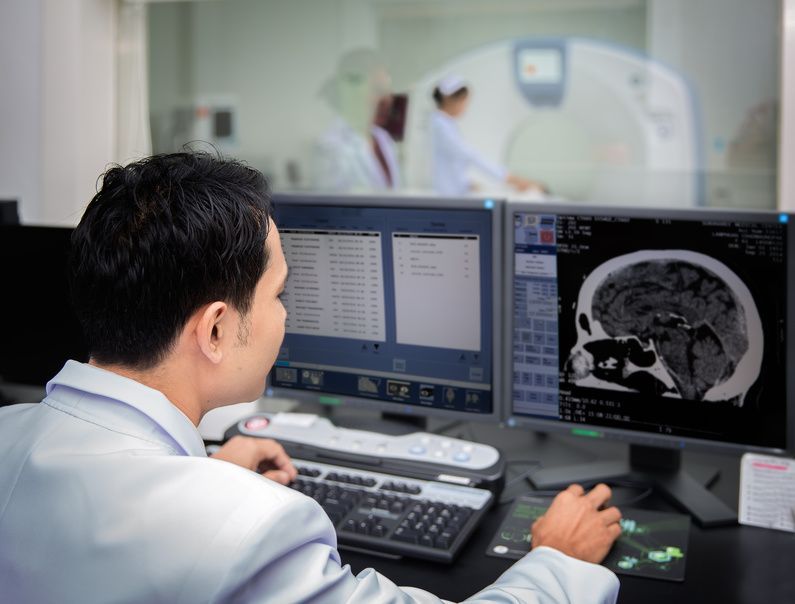
Lung Cancer Rates are Down, but Lung Cancer is Still the Leading Cause of Cancer Deaths

The good news is that lung cancer rates are dropping. The bad news is that lung cancer is still the leading cause of cancer deaths. Screenings can help doctors detect signs of lung cancer early, while the disease is most responsive to treatment.
Lung cancer is an uncontrolled growth of abnormal cells in one or both cells. As areas of abnormal cells grow, tumors can form to interfere with breathing. Lung cancer often starts in the cells that line air passages.
Medical professionals often discuss cancers of the lung and bronchus together. Bronchi are the main passageways in the lungs; the word “bronchus” describes any one of these passageways. Lung and bronchus cancers affect the lungs or their passageways.
Lung Cancer Rates are Dropping
Doctors will have diagnosed about 222,500 new cases of lung cancer in the United States in 2017, according to the American Cancer Society, and cancers of the lung or bronchus will have claimed 155,870 that year.
Lung cancer is currently responsible for one out of four cancer deaths. In fact, more people die of lung cancer each year than of breast, colon, and prostate cancers combined. This means lung cancer is extremely serious.
Lung cancer is also common. In fact, lung cancer is the second most common type of cancer diagnosed in men and women. About 14 percent of all new cancers are lung cancers. There is about a 1 in 14 chance that a man will develop lung cancer in his lifetime. A woman’s risk is about 1 in 17.
Lung Cancer Trends in the United States
Lung cancer rates have been dropping among men for several decades, but the rates of lung cancer have started to drop among women for only the past decade or so.
The incidence of lung and bronchus cancer began to decline in men beginning in the late 1980s. Between 1990 and 1996, incidence rates for lung and bronchus cancers decreased by 2.6 percent per year. Incidence rates of lung and bronchus cancers among females did not even begin to stabilize until the late 1990s.
The incidence of lung cancer has dropped significantly for men in the new millennium, but the reduction in lung cancer incidence remains sluggish in women. Lung cancer incidence dropped by 2.5 percent each year from 2003 to 2012 among men, but only 0.9 percent each year during that timeframe among women.
The death rate of lung cancer decreased 2.7 percent among men each year during that decade, and decreased by 1.4 percent among women during that time.
The main reason mortality rates from lung cancer have dropped is that fewer Americans are smoking. Smoking rates reached their peak in 1954, when 45 percent of all adults smoked. The habit remained at a steady 40 percent from its peak through the 1970s, when smoking rates started to decline. The average rates of smoking went from 40 percent in the 1970s to 32 percent in the 1980s, down to 26 percent in the 1990s and 24 percent during the 2000s.
There is a gender gap in cigarette smoking trends, and this gender gap may be why lung cancer mortality rates have only recently begun to drop among women. Daily cigarette consumption among male smokers peaked during the 1970s, but daily cigarette consumption among female smokers did not peak until the 1980s. Daily cigarette consumption dropped at the same rates among male and female smokers, but this still put women behind the curve when it came to a decline in smoking rates.
Screening for Lung Cancer
Despite the very serious outlook of lung cancer, early detection and treatment can improve chances of survival. In fact, more 430,000 people alive today had received a lung cancer diagnosis at some point in their lives. Survival often depends on the stage at which the cancer was diagnosed.
Lung cancer screening is the best way to identify risk factors for the disease before symptoms ever appear.
The U.S. Preventive Screening Task Force (USPSTF) recommends yearly screenings with low-dose computed tomography (LDCT) in adults aged 55 to 80 years who currently smoke or who have quit within the previous 15 years. LDCT scans the patient’s chest to detect changes in lung tissue or other biomarkers that can indicate the development of lung cancer.
LDCT uses up to 90 percent less radiation than standard computed tomography (CT) exams, which makes the test safe for men and women. The screening tool is accurate enough to detect a large variety of abnormal changes associated with lung cancer. LDCT screens that reveal abnormalities can provide important information to help healthcare providers prescribe a course of care and monitoring to help decrease a patient’s risk of developing lung cancer.
For more information on lung cancer and screening for lung cancer using LDCT, make an appointment with your doctor.




